The iPhone 4 Redux: Analyzing Apple's iOS 4.0.1 Signal Fix & Antenna Issue
by Brian Klug & Anand Lal Shimpi on July 15, 2010 12:28 PM EST- Posted in
- Smartphones
- Apple
- iOS 4
- iPhone 4
- Mobile
Better at the Low End, Mixed Feelings Everywhere Else
Brian came up with the plan to enable the numerical signal strength visualization and executed on it very well in our original iPhone 4 review. Since then there’s been a disturbing amount of debate as to whether or not this actually amounts to a problem with the phone.
Part of the confusion stems from the fact that doing this sort of antenna testing in a real world scenario is time intensive. As Brian mentioned on the previous page, for today’s article both of us were driving around our respective cities, stopping at various locations, measuring signal strength and comparing it to bar mappings in order to produce the charts you saw on the other page.
There’s no denying that Apple has played a significant role in why there continues to be debate about the iPhone 4 antenna. By simply addressing the pre-4.0.1 bars not being a good representation of signal strength and ignoring the fact that the iPhone 4 does lose more signal strength than competing phones depending on how you hold it, Apple manages to convince its faithful that there’s nothing wrong while driving its critics to demand a recall.
My mother always taught me that honesty is the best policy and presumably I’m not the only one in the world who was privy to this information. Had Apple come clean with both of these facts (the bar mapping and the signal attenuation issue) early on we’d be in a far more clear cut world today.
We have consistently argued that the 4’s antenna is a design choice by Apple. As we’ve seen in our testing there are situations where the iPhone 4’s antenna makes things better (e.g. holding onto calls with very low signal strength) and other situations where the design makes them worse (e.g. holding it wrong in situations with low signal strength). I wanted to describe the inconsistency in greater detail so I went out with an iPhone 3GS and 4 and documented my experiences.
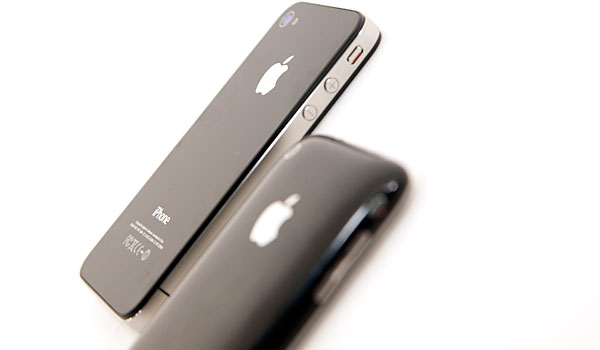
In practice I found three things that were true about the iPhone 4’s antenna behavior compared to the 3GS.
Reception in average conditions is sometimes significantly better on the iPhone 4 than on the 3GS. Take a look at the image capture below. In the same exact location we have better reception on the 4 than the 3GS. Granted this could be due to a number of variables outside of the phone’s antenna itself, but it happened enough times that it’s worth reporting. This is the positive to Apple’s external antenna design - you can and do get better reception. Unfortunately the tradeoff is the scenario I just described before this.
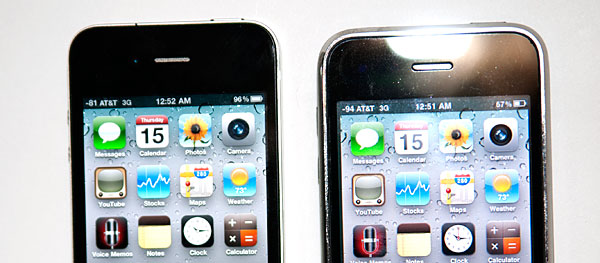
iPhone 4 (left) at -81 dBm vs. iPhone 3GS (right) at -94 dBm
Signal strength is sometimes the same as or worse than the iPhone 3GS. This is really where the problem comes into play. In the shot below I have the 4 and 3GS sitting next to one another and they are displaying roughly the same signal strength. We’ve already proven that holding the iPhone 4 attenuates its signal more than the 3GS, which results in the frustration we’ve seen expressed by many at this point. In situations where the 4 has the same signal as the 3GS, holding the phone is going to drop it to levels significantly worse than the 3GS. If you’re in an area with low signal strength to begin with, holding the phone is going to bring you down to dangerously low levels.
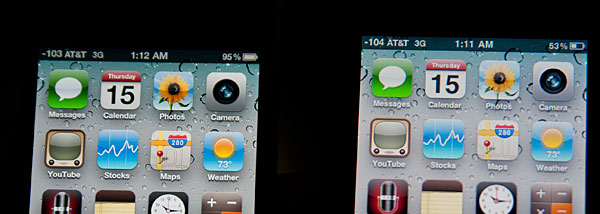
iPhone 4 (left) at -103 dBm vs. iPhone 3GS (right) at -104 dBm
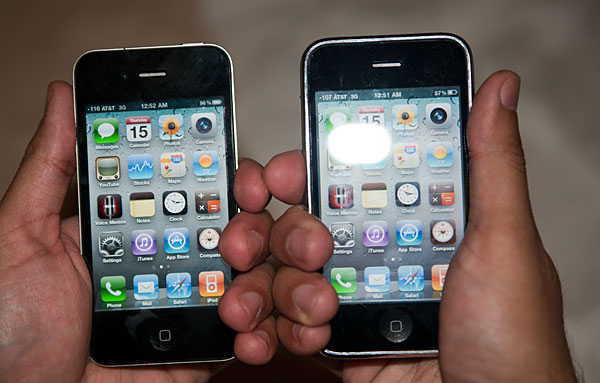
iPhone 4 being held tightly (left) at -115 dBm vs. iPhone 3GS being held tightly (right) at -107 dBm
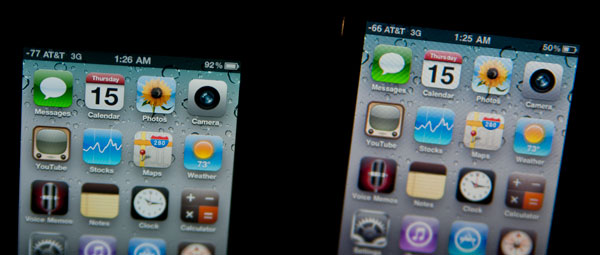
iPhone 4 (left) at -77 dBm vs. iPhone 3GS (right) at -66 dBm
The iPhone 4 is better at holding onto calls and data at very low signal levels. We’ve mentioned this one before but it’s worth reiterating. The new antenna does let me make calls and transmit data at very low signal strength. With the iOS 4.0.1 update I was able to make a call at -115dB on the 3GS, however the call did drop within a minute of starting it. By comparison I was able to have a much longer conversation without dropping the call at -120dB on the 4. By no means is this a scientific comparison, but anecdotally both Brian and I feel that the low signal strength performance of the iPhone 4 is better than the 3GS.
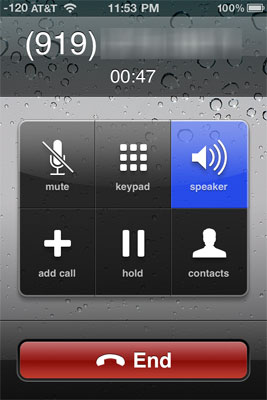
A call at -120 dBm on the iPhone 4
If you’re keeping tabs you’ll note that this is what is traditionally referred to as a trade off. Apple opted for good performance in low signal situations (and style of course) over maintaining consistently better or unchanged radio performance compared to the 3GS. I would personally consider this to be an unnecessarily risky design choice, particularly for a smartphone vendor. Note that it's nearly impossible to separate out the antenna from the rest of the iPhone 4 platform to determine exactly what is responsible for the phone's signal sensitivity in various situations. All we ultimately know is how physically interacting with the antenna impacts reported signal strength.
I can’t stress enough that this issue impacts all users. The variability is in how strong of a signal you have to begin with. That’s the absolute only reason there’s debate in these discussions from phone to phone. At my desk I don’t get great reception on AT&T. With the iPhone 4 I’m usually at -96dBm. If I keep a tight grip on the phone or if I’m holding it to send text messages I can sometimes lose all signal entirely. This is a combination of poor reception at my house and the fact that the 4 loses more of its signal than other phones when held certain ways.
Brian on the other hand has much better reception at his home. To him, the signal strength drops but it does not drop enough for this to be a problem. I consider myself to be on the border. If I’m mindful of how I’m holding the phone it’s not an issue, and even most of the time if I’m not paying attention to it it’s not an issue. However there are definitely times when it does become a problem. I wouldn’t consider it to be the majority of the time or even more than 10% of the time, but it happens enough for me to have to think about it. Ultimately this is why I consider Apple’s design here to be unnecessarily risky. Introducing a change with stylistic and technical benefits where the downside is limited but potentially very noticeable is just ballsy.
Luckily for Apple, there are things that can be done about it.










146 Comments
View All Comments
canontk - Thursday, July 15, 2010 - link
I'm not trying to defend Anand and his love for Apple, but you must understand this site started from his love for computers and things technical. I've been coming to this site for over 12 years now and I dislike seeing the constant Apple articles just as much as the next guy, but I respect Anand and most of his staff.You'll just have to learn to deal with it or find another site. The problem is that most sites are big on Apple news and reviews just to get the traffic. I don't think this is why Anandtech posts Apple news and reviews, I think it's because they really like their devices.
We get good information from their interests, we just have to hope some of those are the same as ours.
jonup - Thursday, July 15, 2010 - link
I think what you said is worrisome(?). Fact is that Apple has a marginal presence in the cell phne market (though growing at very fast pace) but they products receive dispropotional presence on review site, even on sites like AT where cell phones are not the core content.Apple is getting PR (intential or not) that sometimes even I want to get an iPhone. I almost installed a Hachintosh a few months ago. I meen I will never (!?) get an iPhone cause they do not make them in the form factor I prefer (small, light, and durable).
SunSamurai - Thursday, July 15, 2010 - link
Marginal presence? Apple has a 15-20% share in the smart phone industry. How is that marginal?They dont make ANY smartphone in a small light form factor. What in the h3ll are you talking about and how does that have anything to do with the iphone vs any other smart phone?
jonup - Friday, July 16, 2010 - link
15-20% of the US smartphone market and that is namely because pin-point marketing like the one in question. (At one point even I was convinced to by an iPhone, silly me!)A year old Nokia E52 - 3.4Oz. 54cc. You didn't hear about this one, did you? Sorry they were to busy reviewing iPhone 3GS.
SunSamurai - Friday, July 16, 2010 - link
15-20% is not negligible. Your excuses are pathetic.Nokia E52:
Dimensions: 116 x 49 x 9.9 mm
Weight: 98 g
iPhone4:
Dimentions: 115 mm x 58.6 mm x 9.3 mm
Weight: 137g
OMG THE iPHONE IS SO HUGE.
Have fun with your small-ass screen. I have no connection issues on my iphone. No one cares about the E52.
jonup - Saturday, July 17, 2010 - link
That is 40% more weight and 12% more volume. The E52 is a year old phone. Compared to the year old 3Gs that is 40% and 55% more weight and volume.And then comes the building quality. Check out a review of the phone to see what I mean. As a testimony, my old 6301 had only a small dent on the forged aluminum battery cover after 2.5+ years of abuse of falling on concrete.
3.5" is definately better than 2.4" but it does not provide for significantly better usability. if 2.4" is a limitation for performing a particular task, chances are 3.5" would still not be enough. Besides you give up the single handed imput capability.
Tegeril - Monday, July 19, 2010 - link
Sorry, SunSamurai is right. No one cares about the E52.canontk - Friday, July 16, 2010 - link
How is what I said worrisome? Worrisome because the people that write for this site like Apple products? A lot of people do. I don't. I have an ipod nano (first gen) and I'm sorry I wasted the money on it.I won't get an iphone and I don't like seeing constant Apple news. But like I said, Anand likes his Macs and Apple devices, good for him. He's going to do articles on what he likes.
He also seems to be very fond of SSD's and their market share is extremely low. I don't see people complaining about his 15 page super detailed articles and constant updates on firmware.
SunSamurai - Friday, July 16, 2010 - link
Yeah exactly. Anand is doing articals on what is changing the industry. SSDs or Apple or the Droid review.Love them or hate them, Apple is an industry lead, and things they produce are copied and often improved upon. We owe them a dept of gratitude. Do not think for a moment we'd have something like Driod if not for them. We'd have the MS Kin phones and Google would not have had to make anything close to the current droids.
This is business.
jonup - Saturday, July 17, 2010 - link
Except that Anand is reviewing all kinds of SSDs not just one brand. If Anand was reviewing Intel of OCZ SSds 75%+ of the time then your analogy would have been correct. How many Symbian phones has this or most computer-centric site have reviewed since July 2007? The platform is used by Nokia and SonyEricsson. The two combined maintain more than 50% of the cell phone market. You would think they need a little more representation.@ SunSamurai bellow:
I've grown up to like Apple products lately (not the brand) but Apple is the one that copies and improves upon others. Neither iPod was the first portable player, nor the iPhone the first touchscreen phone, nor iPad the first tablet, nor iPhone 4 the first videophone. I do not question Apples influence on the IT market, but simply asking how much of the hype is result of dispropotionate review coverage.